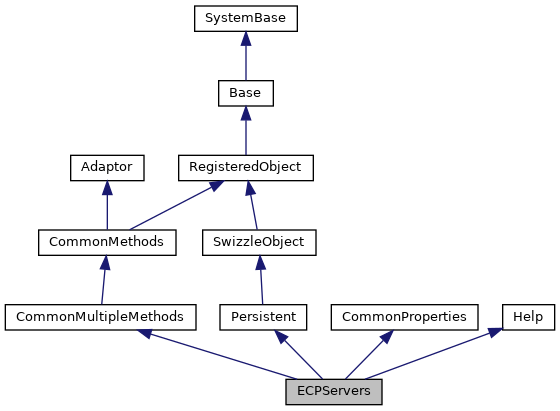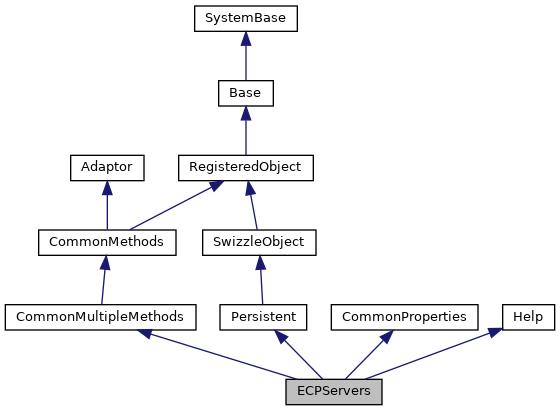This class allows you to modify and view the [ECPServers] section of the CPF file through programatic APIs. More...


Public Attributes | |
| Address | |
| IP Address to connect to. More... | |
| BatchMode | |
| ECP Server runs in batch mode. More... | |
| MirrorConnection | |
| Specifies the behavior of this connection with regard to mirrored database servers. More... | |
| Port | |
| IP Port to connect to. More... | |
| SSLConfig | |
| Use SSL configuration (ECPClient) for the ECP connection. More... | |
 Public Attributes inherited from CommonProperties Public Attributes inherited from CommonProperties | |
| CPFFile | |
| CPF file which the object maps to. More... | |
| Comments | |
| Embedded comments in the CPF file. More... | |
| Flags | |
| Flags governing how the object is processed when Save() is called. More... | |
| Name | |
| Name of the object instance. More... | |
Static Public Attributes | |
| CAPITALNAME = None | |
| Server name is always capitalized. More... | |
 Static Public Attributes inherited from CommonMultipleMethods Static Public Attributes inherited from CommonMultipleMethods | |
| CAPITALNAME = None | |
| Determines if the Name specified in the index should be capitalized. More... | |
| SECTIONTYPE = None | |
| This parameter governs how the class creates audit records. More... | |
 Static Public Attributes inherited from CommonProperties Static Public Attributes inherited from CommonProperties | |
| DOMAIN = None | |
| This class contains properties which are included by classes which manipulate sections in the CPF file. More... | |
This class allows you to modify and view the [ECPServers] section of the CPF file through programatic APIs.
While properties are usually modified through the System Management portal, there may be some occasion where modifying them through the API's is best for your system. In all the Config methods, if you do not specify the CPFFile parameter, the currently active CPF file is used. If you wish to modify a CPF file which is not the currently active one, then specify the CPFFile you wish to modify in the method call.
The Flags parameter does not normally need to be specified; the defaults are usually sufficient for most cases.
You can use either the provided API's (Create/Get/Modify/Delete) to modify the properties by passing in the correct parameters, or use Object syntax to open and directly manipulate the config objects (Open() and Exists()). Most objects created here need only to specify the Name of the object, and 1 or 2 properties since the the defaults are what are commonly used for most cases.
EXAMPLE:
; Use class methods to create an instance
SYS>s Name="SERVERA"
SYS>s Properties("Address")="127.0.0.10"
SYS>s Status=##Class(Config.ECPServers).Create(Name,.Properties)
SYS>i 'Status w !,"Error="_$SYSTEM.Status.GetErrorText(Status)
; Use class methods to modify properties
SYS>s Status=##Class(Config.ECPServers).Get(Name,.Properties)
SYS>i 'Status w !,"Error="_$SYSTEM.Status.GetErrorText(Status)
SYS>zw Properties
Properties("Address")="127.0.0.1"
Properties("Port")=1973
SYS>s Properties("Port")=1972
SYS>s Status=##Class(Config.ECPServers).Modify(Name,.Properties)
SYS>i 'Status w !,"Error="_$SYSTEM.Status.GetErrorText(Status)
; Now use Objects to modify properties
SYS>s Obj=##Class(Config.ECPServers).Open(Name)
; We could have used i ##Class(Config.ECPServers).Exists(Name,.Obj) instead of Open()
SYS>w Obj.Port
1972
SYS>s Obj.Port=1975
SYS>s Status=Obj.Save()
SYS>i 'Status w !,"Error="_$SYSTEM.Status.GetErrorText(Status)
; Now delete the object we just created
SYS>s Status=##Class(Config.ECPServers).Delete(Name)
SYS>i 'Status w !,"Error="_$SYSTEM.Status.GetErrorText(Status)
|
static |
Server name is always capitalized.
| Address |
IP Address to connect to.
| BatchMode |
| MirrorConnection |
Specifies the behavior of this connection with regard to mirrored database servers.
Value: 0: Non-mirrored connection. Access databases on non-mirror members. Also used to connect to async members to access mirror databases, configured by their database paths. 1: Mirrored connection. ECP will automatically find the primary mirror member and will only connect to the primary. Access to mirrored databases is configured by mirror database name. -1: Mirrored connection restricted to the configured mirror member only. The configured member is the one specified by <PROPERTY>Address</PROPERTY> and <PROPERTY>Port</PROPERTY>. Like value '1', a connection will be established if the configured member is primary and access to mirrored databases is configured by mirror database name. Unlike '1', if the configured member is a Disaster Recovery member, the connection will be established, allowing read-only access to mirrored databases. If the DR member is promoted, the connection will be dropped and will be re-established when it becomes primary. Warning: This setting is not appropriate in typical configurations where mirroring will automatically fail over, as the new primary won't be found. This is for use in specialized DR configurations, or other long-distance configurations, to prevent the application server from being automatically redirected to a primary in a different data center while allowing local read-only access. There is no system utility to set the value of '-1', but it can be specified via this class interface.
| Port |
IP Port to connect to.
| SSLConfig |